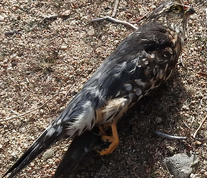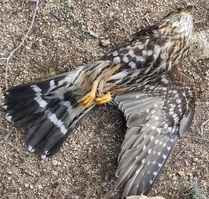
At the risk of branding myself the dead bird lady, look what I found in my yard this time.
It was about 7:00 am December 4 as I walked across our little orchard, and there lay this still-limp bird. The first thing I noticed was how heavy it was for a bird only about ten inches long. The second thing I noticed was that one of its wings had been ripped off! Not a great way to start the day – his or mine.

Merlins are apparently pretty common both in the US and Europe, and winter in the kind of coniferous and mixed-height forests where I live here in California. The size and coloration seem right, as does the sharp falcon beak. Based on its grey/blue back feathers, I think it’s a male.
Audobon describes the Merlin as a small, stocky falcon. Beauty of Birds says it is more “heavily built” than most falcons, which fits my impression that it was heavy for a bird of its size. (I suppose most people don’t go around picking up dead birds, but I have been surprised several times by how light they usually are. Not this one.)
According to Birds of Beauty, the Merlin “is quite unafraid, and will readily attack anything that moves conspicuously. Merlins have even been observed trying to ‘catch’ automobiles and trains…”
That sounds like a good way to get your wing ripped off, but there are no trains, cars or even windmills close enough for him to have ended up here.
Beauty of Birds also says, “Adult Merlins may be preyed on by larger raptors, especially Peregrine Falcons (F. peregrinus), eagle-owls (e.g. Great Horned Owl, Bubo virginianus) and larger Accipiter hawks (e.g. Northern Goshawk, A. gentilis). In general however, carnivorous birds avoid Merlins due to their aggressiveness and agility”
He may have lost his wing to an owl shortly before my dog and I stumbled upon the scene. Or maybe he tried to attack something he shouldn’t have like a coyote, fox or mountain lion. Those all wander these parts.
He was definitely a thing of beauty, even in death. I wish I had spotted him when he still lived.
